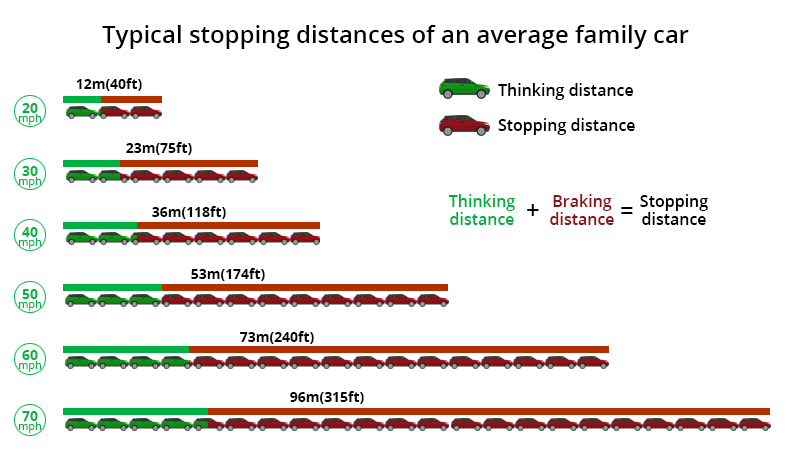Braking Distances on Ice
With the winter weather fast approaching it means more care and consideration is needed on the roads – but specifically? You need to radically rethink your braking distances if you find yourself driving on ice.
Braking distances on ice can be 10 times greater than regular breaking distances
Which means some serious distance is covered between your initial reaction and the car you’re driving actually stopping. Here are the numbers:
That would mean if you were driving on the motorway, you’d cruise almost ¾ of a km before the car finally stopped – assuming you stay in a straight line of course.
Let’s break the numbers down (or jump down for what to do if you find yourself driving on ice)
The Stopping Distances on Ice:
Stopping/breaking distances are made up of two key elements – thinking time and stopping time. Then added in is the ice factor. That means Thinking Time + (Braking Distance x 10). The breakdown of braking distances on ice for your average family car looks something like:
How Can You Tell If You Are Driving On Ice?
If you find yourself driving on ice then chances are you’re going to feel it rather than see it, particularly if you find yourself on black ice:
- The steering will feel lighter
- The steering will feel unresponsive
- There’s unlikely to be any sound coming from the tyres
How to Drive on Ice:
As with most driving situations, preparation is key if you’re going to be driving in wintry conditions. When it comes to ice the best advice on offer is Rule 231 from the Highway Code. You can read the full rules about driving in different weather conditions here:
“Drive extremely carefully when the roads are icy. Avoid sudden actions as these could cause loss of control. You should:
- drive at a slow speed in as high a gear as possible; accelerate and brake very gently
- drive particularly slowly on bends where loss of control is more likely. Brake progressively on the straight before you reach a bend. Having slowed down, steer smoothly round the bend, avoiding sudden actions
- check your grip on the road surface when there is snow or ice by choosing a safe place to brake gently. If the steering feels unresponsive this may indicate ice and your vehicle losing its grip on the road. When travelling on ice, tyres make virtually no noise.”
What Do You Do When Your Car Is Sliding On Ice?
If you find yourself in a position where you start sliding on the ice then rule number 1 is to NOT panic. There are number of things you can do to limit or completely avoid a potential crash. These things are much easier to see rather than read, so iceroadsafety.com have put together this video covering how to correct your car if you slide, with incredibly useful examples of what to do (and what not do to do) if you end up losing control on the ice.
Go to icyroadsafety.com to read more!
If looking to keep safe during your drives this winter then check out our other posts:
